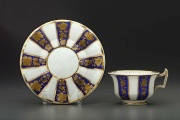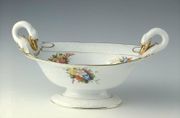Difference between revisions of "Bone china"
Jump to navigation
Jump to search
(username removed) |
|||
| (4 intermediate revisions by 4 users not shown) | |||
| Line 1: | Line 1: | ||
| − | [[File:00.381a-b-SC8863.jpg|thumb|]] | + | [[File:00.381a-b-SC8863.jpg|thumb|Cup and Saucer<br>MFA # 00.381]] |
== Description == | == Description == | ||
| − | A strong, ivory-white, translucent [ | + | A strong, ivory-white, translucent [[porcelain]] made with [[kaolin]] and about 25-50% [[bone ash]]. Bone china was invented by Josih Spode in the 1740s in England. While trying to duplicate Chinese porcelain, he discovered that [[china clay]] could be strengthened during and after firing with the addition of bone ash. Bone ash is a white [[calcium phosphate]] powder obtained from calcined cattle bones. Bone china is biscuit-fired at 1250-1300 C then glost fired with a [[lead]] or [[borax]] glaze at 900-1000 C. |
| − | + | [[File:Compote 65.2199.jpg|thumb|Compote<br>MFA# 65.2199]] | |
== Synonyms and Related Terms == | == Synonyms and Related Terms == | ||
| − | bone-china; English china; porcelaine tendre (Fr.); porcelana | + | bone-china; English china; porcelaine tendre (Fr.); porcelana fosfática (Port.) |
| − | == | + | == Resources and Citations == |
| − | * | + | * Robert Fournier, ''Illustrated Dictionary of Practical Pottery'', Chilton Book Company, Radnor, PA, 1992 |
* ''The Dictionary of Art'', Grove's Dictionaries Inc., New York, 1996 Comment: 'Ceramic' | * ''The Dictionary of Art'', Grove's Dictionaries Inc., New York, 1996 Comment: 'Ceramic' | ||
| − | * | + | * G.S.Brady, ''Materials Handbook'', McGraw-Hill Book Co., New York, 1971 Comment: p. 429 |
| − | * | + | * Richard S. Lewis, ''Hawley's Condensed Chemical Dictionary'', Van Nostrand Reinhold, New York, 10th ed., 1993 |
| − | * | + | * Random House, ''Webster's Encyclopedic Unabridged Dictionary of the English Language'', Grammercy Book, New York, 1997 |
* ''The American Heritage Dictionary'' or ''Encarta'', via Microsoft Bookshelf 98, Microsoft Corp., 1998 | * ''The American Heritage Dictionary'' or ''Encarta'', via Microsoft Bookshelf 98, Microsoft Corp., 1998 | ||
Latest revision as of 12:55, 4 August 2020
Description
A strong, ivory-white, translucent Porcelain made with Kaolin and about 25-50% Bone ash. Bone china was invented by Josih Spode in the 1740s in England. While trying to duplicate Chinese porcelain, he discovered that China clay could be strengthened during and after firing with the addition of bone ash. Bone ash is a white Calcium phosphate powder obtained from calcined cattle bones. Bone china is biscuit-fired at 1250-1300 C then glost fired with a Lead or Borax glaze at 900-1000 C.
Synonyms and Related Terms
bone-china; English china; porcelaine tendre (Fr.); porcelana fosfática (Port.)
Resources and Citations
- Robert Fournier, Illustrated Dictionary of Practical Pottery, Chilton Book Company, Radnor, PA, 1992
- The Dictionary of Art, Grove's Dictionaries Inc., New York, 1996 Comment: 'Ceramic'
- G.S.Brady, Materials Handbook, McGraw-Hill Book Co., New York, 1971 Comment: p. 429
- Richard S. Lewis, Hawley's Condensed Chemical Dictionary, Van Nostrand Reinhold, New York, 10th ed., 1993
- Random House, Webster's Encyclopedic Unabridged Dictionary of the English Language, Grammercy Book, New York, 1997
- The American Heritage Dictionary or Encarta, via Microsoft Bookshelf 98, Microsoft Corp., 1998
- Art and Architecture Thesaurus Online, http://www.getty.edu/research/tools/vocabulary/aat/, J. Paul Getty Trust, Los Angeles, 2000

